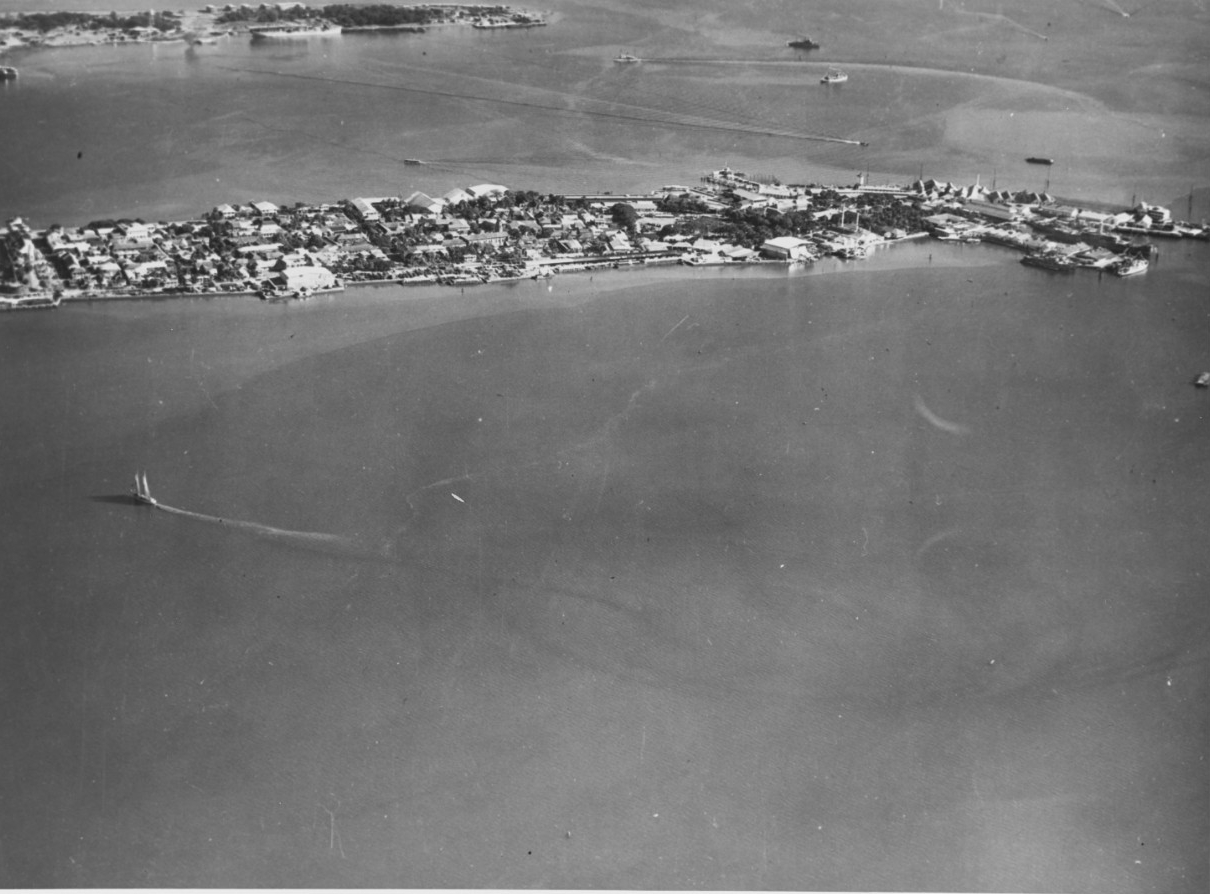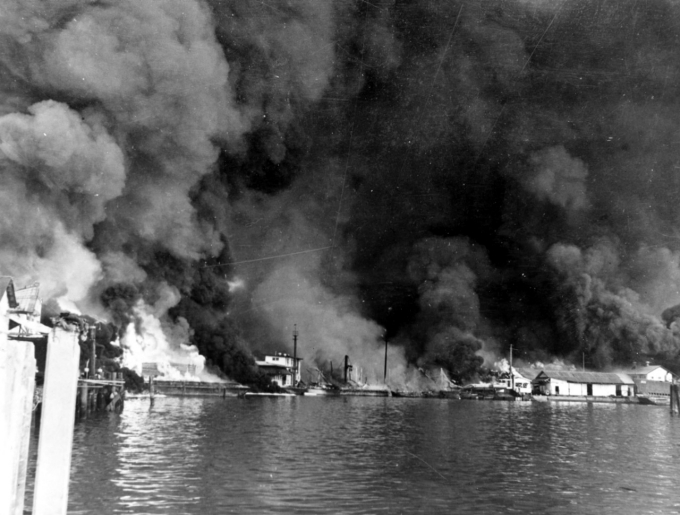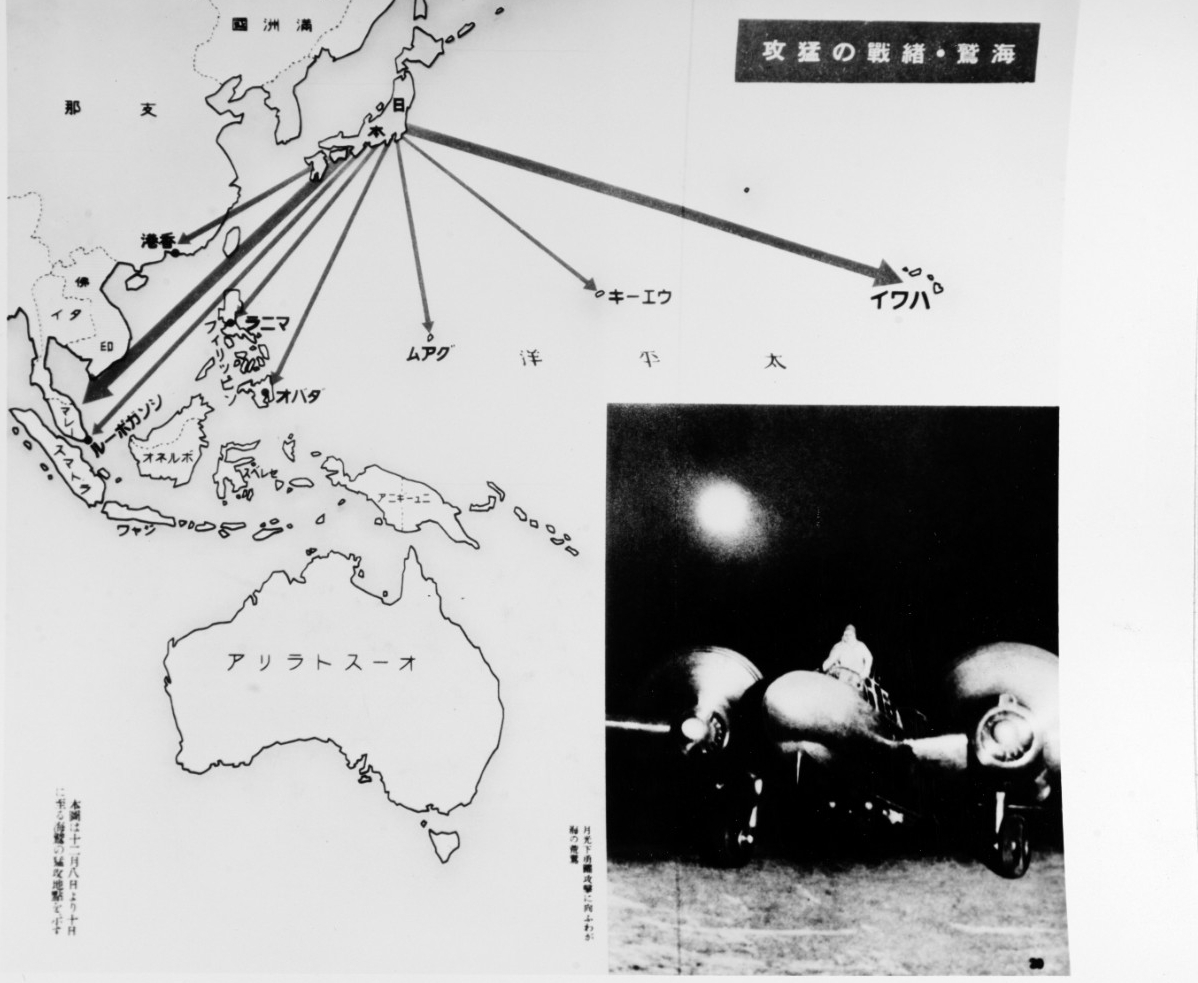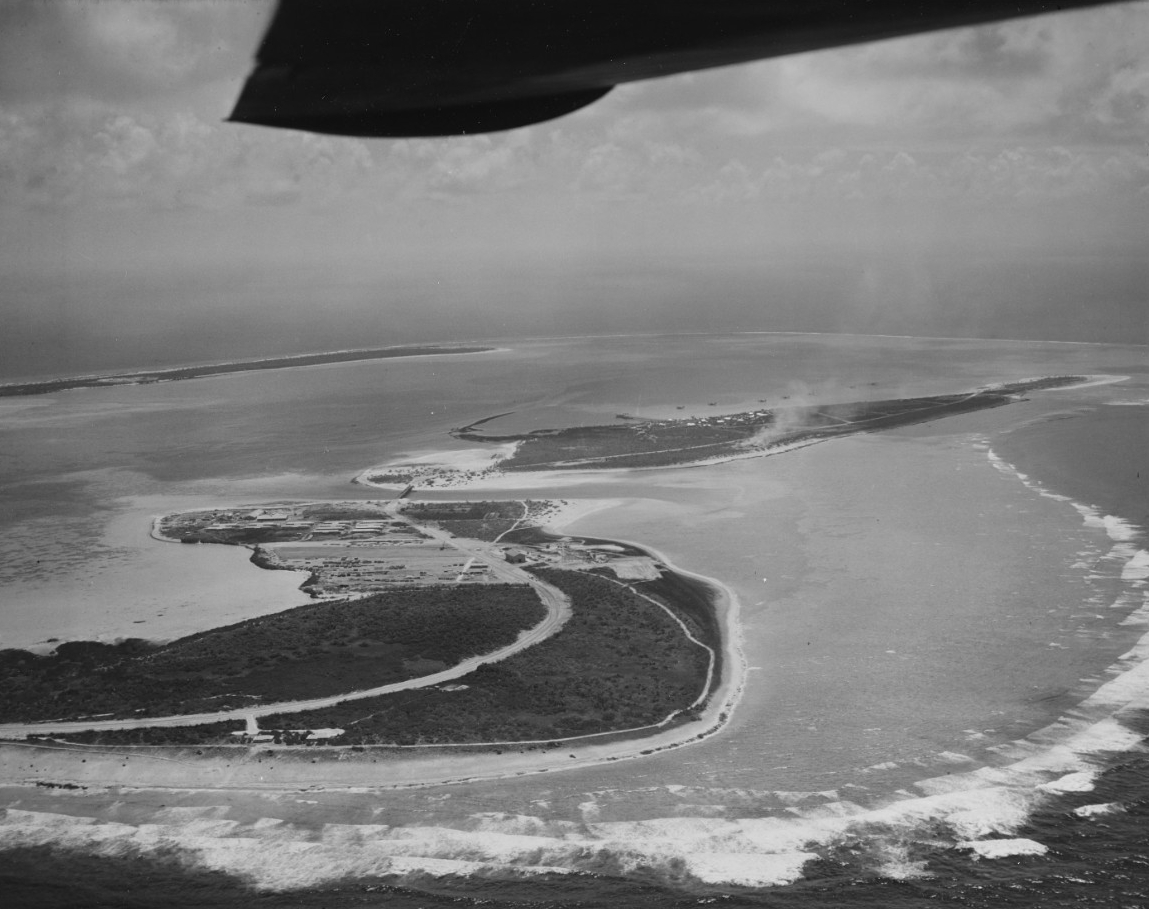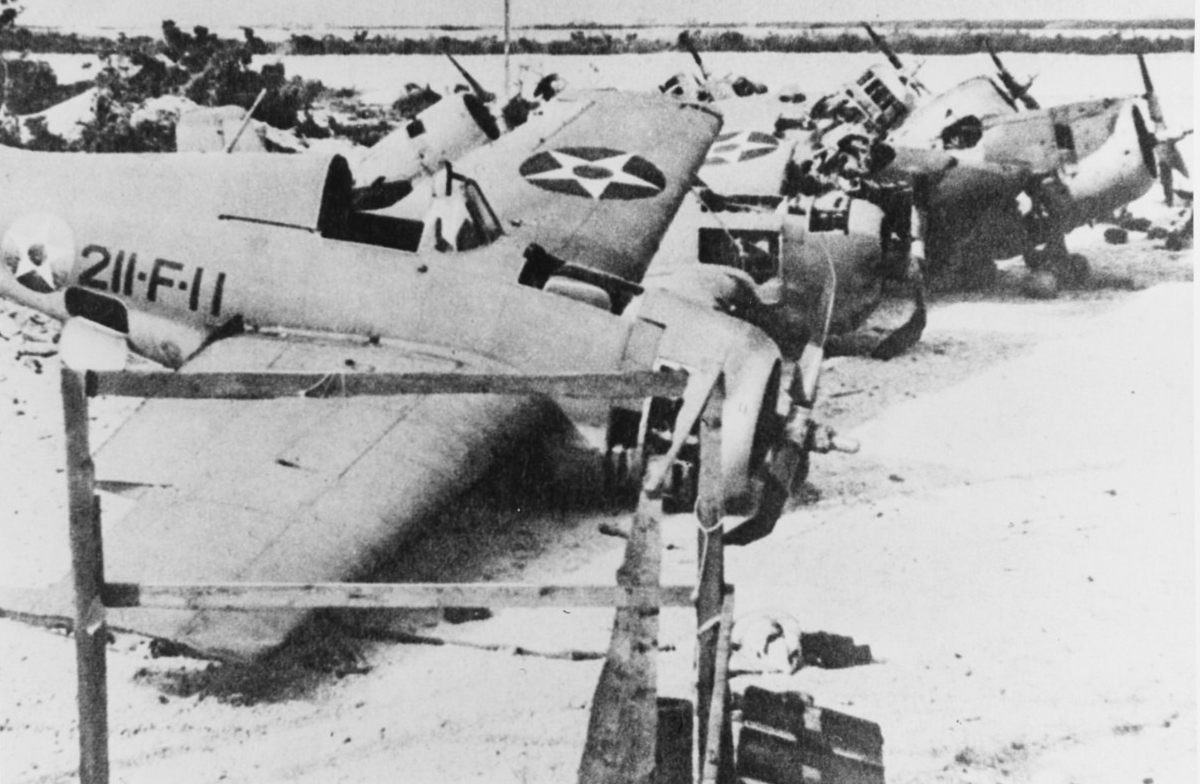Attacks on the Philippines, Guam, and Wake
80-G-178320. Cavite Navy Yard, Philippines, with Sangley Point in the left distance, 27 October 1941. The larger ship docked at the Navy Yard (near right edge of image) is USS Canopus (AS-9). Canopus would be scuttled off of Bataan in 1942. USS Langley (AV-3, formerly CV-1), which supported neutrality air patrols, is tied up at Sangley Point (upper left center). She would be scuttled after receiving extensive damage from a Japanese bombing attack in 1942. Official U.S. Navy photograph, now in the collections of the National Archives. Click image to download.
Attack on the Philippines, 8 December 1941
On 8 December 1941, as prelude to multiple amphibious landings in the Philippines, the Japanese launched air attacks on U.S. and Filipino bases. Cavite Navy Yard, primary base of the U.S. Asiatic Fleet, was first bombed on 10 December and had been largely destroyed by the time of the evacuation of Manila on 25 December.
SC 130991. Fires at Cavite Navy Yard, Philippines, resulting from the December 10, 1941, Japanese air raid. Photograph from the Army Signal Corps Collection in the U.S. National Archives. Click image to download.
Attacks on Guam and Wake, 8 December 1941
NH 84959. Chart and inset photo of a Mitsubishi G3M medium bomber from the contemporary book: "Photographic History of Naval Strategy." Translation of captions: "This chart shows points attacked by our Navy Eagles, 8–10 December. Left to right: Hong Kong, Kota Bharu, Singapore, Manila, Davao, Guam, Wake, Hawaii."
The tropical island of Guam with an area of 212 square miles, is 13 degrees north of the equator and nearly 3,300 miles southwest of Hawaii. By March 1941, the Empire of Japan was already flying photo reconnaissance over the island. By September of that year, the plans for an invasion of Guam were completed.
On 8 December 1941, Captain George J. McMillan, USN, the governor of Guam, was informed about the attack on Pearl Harbor. That morning on Guam, Japanese aircraft from Saipan struck the minesweeper Penguin (AM-33), the largest ship at the island and sent her to the bottom after she shot down at least one Japanese airplane. The following day, Japanese attacks continued with nine aircraft attacking the island.
The Japanese put ashore approximately 400 men from Saipan’s 5th Defense Force at Dungcas Beach early on 10 December. They attacked and quickly defeated the Insular Force Guard in Agana. They then advanced on Piti, moving toward Sumay and the Marine Barracks. The principal engagement took place on Agana’s Plaza de Espana at 0445 when several Marines and Insular Force Guardsmen fought with the Japanese naval soldiers.
Captain McMillan was aware that he could expect no reinforcements or relief and worried for the fate of the 20,000 Guamanians, all American nationals, who would surely suffer if a strong defense was mounted. He felt that, “the situation was simply hopeless.” After token post invasion resistance, the Marines, on McMillan’s orders, surrendered at 0545. The governor—Captain McMillan—officially surrendered shortly afterward.
A few more skirmishes took place across the island before news of the surrender spread and the rest of the U.S. forces laid down their arms. The American patrol boat YP-16 was scuttled by fire during the fighting, YP-17 was captured by Japanese naval forces, and an American freighter was damaged. In two days of bombing and fighting, the garrison lost 19 men killed and 42 wounded, including four Marines killed and 12 wounded.
During this time, the Japanese South Seas Detached Force sent 5,500 men under the command of Major General Tomitarō Horii to make separate landings at Tumon Bay in the north, on the southwest coast near Merizo, and on the eastern shore of the island at Talafofo Bay.
Guam remained under Japanese control for 31 months until 21 July 1944 when United States forces returned and liberated the island after weeks of intense fighting, leading to more than 7,000 American casualties and over 18,000 Japanese killed.
80-G-411160. Wake Island. Aerial photograph taken from a PBY patrol plane on 25 May 1941, looking west along the northern side of Wake, with Peale Island in the center and right middle distance, and Wilkes Island in the left distance. Official U.S. Navy photograph, now in the collections of the National Archives. Click image to download.
Wake Island, a solitary atoll in the central Pacific, was being developed as a U.S. Navy air station and submarine base at the time of the Pearl Harbor attack. It was also a Pan-American Airlines refueling stop for its “China Clipper” service. Wake was garrisoned by the Fleet Marine Force’s 1st Defense Battalion. Also on hand were officers and sailors of the naval air station detachment, five U.S. Army Signal Corps personnel, and just over 1,200 Pan-American employees and construction contractors. For air defense, a Marine Corps fighter squadron, VMF-211, was belatedly provided on 4 December 1941.
Japanese air raids on Wake commenced on 8 December and destroyed most of VMF-211’s aircraft on the ground, along with much of Wake’s infrastructure. A Japanese landing attempt on December 11 was repulsed but with heavy losses to shore defenses and the surviving VMF-211 aircraft. Follow-on Japanese air attacks and a second amphibious assault on 23 December were more successful. The outnumbered U.S. defenders surrendered later that day. Read more about the battle in The Forsaken Defenders of Wake Island.
80-G-179006. Wrecked Grumman F4F-3 Wildcat fighters of Marine Fighting Squadron 211 (VMF-211), photographed by the Wake airstrip sometime after the Japanese captured the island on 23 December 1941. Official U.S. Navy Photograph, now in the collections of the National Archives. Click image to download.
Learn More
Navy Department Communiques, December 1941 (digitized in Navy Department Library Online Reading Room)
Sources
Robert J. Cressman, The Official Chronology of the U.S. Navy in World War II. Annapolis, MD/Washington, DC: Naval Institute Press/Naval Historical Center, 1999.
Samuel Eliot Morison, History of United States Naval Operations in World War II, Vol. III—CThe Rising Sun over the Pacific, 1931–April 1942. Boston: Little, Brown and Company, 1950.

